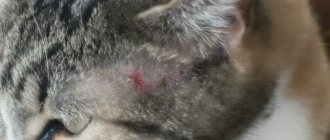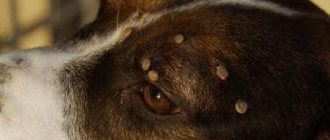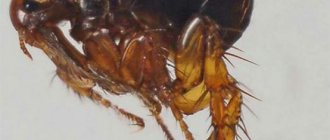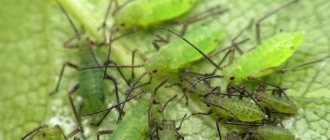What are fleas on dogs and cats
Fleas are small, wingless, blood-sucking insects. The lack of the ability to fly is compensated by very developed legs, due to which they are able to cover distances of up to 1 meter in length and 1.5 in height.
Fleas live up to two months.
Their development cycle consists of eggs, larvae, pupae and adults. Contrary to popular belief, fleas do not live on animals. We can say that our pets are just a “dining table” for them. The time they spend feeding ranges from 1 minute to several hours, so it is not always possible to notice the insect during the meal. Adults feed on the blood of mammals and birds, and attack based on the level of carbon dioxide and vibration, so they rarely attack humans, usually when there is absolutely nothing to eat, we are “not tasty” for them, and besides, we have quite thick skin, which is not so just bite through. After feeding, sexually mature adults lay eggs on the animals' fur, which eventually fall off and fall anywhere. The eggs hatch into larvae, which after several molts turn into pupae. During this period of development, they hide in the cracks of houses, under baseboards, in the carpets and bedding of our apartments, that is, where it is “dark and not visible” and feed on digested blood (the excrement of adult individuals).
In the wild, these are bird nests and animal burrows. Their population, under proper conditions and sufficient food, grows rapidly. According to statistics, only 5% of the population are adult insects, the remaining 95% are eggs, larvae and pupae. During the winter, they do not die out or hibernate, but spend the winter well in basements in the entrances of houses.
That is why it is necessary to carry out treatment throughout the year, and not just in the summer. And therefore, the cat does not have to go outside at all, the fleas will come to her themselves!
Main long worms in cats
Roundworms
In most cases, cats are diagnosed with infection with nematodes such as hookworms and toxocaras.
- Hookworms are small worms up to 1 cm in size. They feed on the host’s blood, leading to anemia and making many wounds in the intestinal walls with sharp teeth. Several dozen of these helminths can lead to the death of a small cat in a matter of days;
- Toxocaras are the causative agents of toxocariasis, white, thin worms reaching a maximum length of 20 cm. They take away useful substances from the cat, causing vitamin deficiency and exhaustion. With severe invasion, they can completely block the intestinal lumen. In young animals whose intestines are too small for such parasites, the intestines may rupture.
Tapeworms (cestodes)
Cestodes are long flatworms, the length of which can reach up to 70 cm. The bodies of cestodes consist of numerous segments, each producing larvae. Tapeworms parasitize the walls of the small intestine.
Detection of diseases caused by tapeworms is much easier, since segments that secrete helminths can often be found near the anus.
- The causative agent of alveococcosis is alveococcus. Small worms, their length does not exceed 1-4 millimeters. They parasitize the intestines.
- Cucumber tapeworms that cause dipylidia reach 20-30 cm in length. They parasitize the intestines.
Flatworms (flukes)
Flatworms in cats are quite rare. Trematodes are often called flukes due to the suckers that are located on their bodies.
Trematodes are white thread-like worms that attach to the intestinal walls using suction cups, causing mechanical damage to the mucous membrane and also have a toxic effect.
Trematodes are much less common than the two previous types of helminths, but it is worms of this species that pose a mortal danger to cats, as they are capable of destroying internal organs and tissues. They parasitize not only the intestines, but also the liver, bladder, and lungs.
- The pulmonary fluke causes paragonimiasis. It reaches 0.3-1 cm in length. It parasitizes the animal’s lungs, forming cysts and destroying lung cells.
- The liver fluke (cat fluke) up to 5 mm long causes opisthorchiasis - a dangerous disease that affects the liver and gall bladder.
We recommend reading: Tablets For Dogs With Meat Flavor Olkar
How to find out if a cat or dog has fleas?
Sometimes you can see adult insects on the skin.
And this process is called flea infestation. In some cases, you can find small black dots on cats' fur; these are flea experiments. If they are placed on damp white paper, they will soon spread, leaving a red-brown mark. This study is called the wet paper test.
But it is not always possible to identify fleas in a cat using this method, since cats spend a lot of time grooming and simply lick off traces of parasite activity with their tongues.
It can also be difficult to detect fleas on a dog, especially in thick fur. The wet paper test can also be useful in this case.
The main symptoms of fleas in cats and dogs
Insect bites often cause allergies in animals and fleas are no exception.
Just like people, not every pet is hypersensitive to flea bites. That is, among several cats living in one apartment infested with fleas, only one may itch. The allergy develops to flea saliva protein and has the following manifestations in cats: restlessness, itching in the head, back, tail, thighs, alopecia, miliary dermatitis, eosinophilic granuloma complex.
In dogs: anxiety, itching in the back, thighs, tail, alopecia, erythema, pyoderma; less often - otitis, pododermatitis. But, unfortunately, the lesions are not always so specific.
Flea saliva remains in the skin for up to several weeks, so a pet bitten by the parasite may itch for quite a long time.
Symptoms of a flea bite
Since flea saliva has strong irritating properties, the animal experiences severe itching at the site of the bite. A dog or cat itches, gnaws on the affected areas of the body, injuring the skin even more, which is often accompanied by the introduction of pathogenic microflora. Classic flea dermatitis develops on the back at the root of the tail, in the groin, and on the stomach. The animal is restless, sometimes aggressive; with a large number of parasites, anemia may develop.
Need to know! An adult flea lays up to 50 eggs per day. More than 95% of the flea population in the house are eggs and larvae that are found in cracks, under baseboards, under furniture, and especially often in fleecy carpets. When the larva hatches, it feeds on the feces of adult fleas and organic debris; can also swallow worm eggs. After this infected larva pupates, it will turn into an adult flea, which will jump on a cat or dog for food - when bitten and eaten by the animal, it will transmit worm eggs to it, which will cause a helminthic disease.
Infections transmitted through fleas
These parasites are quite dangerous for animals in that they can be carriers of such dangerous diseases as hemobartonosis of cats and dipylidiasis of carnivores.
Hemobartonosis is a disease caused by mycoplasmas, also known as feline infectious anemia. Mycoplasmas cause massive death of erythrocytes (red blood cells), which leads to severe anemia and hypoxia, as a result of which the cat can even die!
Dipylidia is a parasitic disease caused by the tapeworm, also known as the cucumber tapeworm because its segments resemble cucumber seeds.
Adult dipylidia live in the small intestine, causing gastrointestinal dysfunction (diarrhea, abdominal pain, etc.) in the host.
Dogs and cats become infected through a flea bite. There are only two diseases in humans caused by the bites of these insects: pulicosis and sarcopsylosis . In addition, bites can transmit more than twenty infections dangerous to humans, including the bubonic plague, which killed half of Europe in the Middle Ages.
How to cure fleas in cats and dogs?
First, it is necessary to treat all animals in the house.
Secondly, be sure to treat the room (floors, baseboards, cracks), resting areas for cats and dogs, and a rug at the front door.
What is important to consider when choosing a drug to treat your pet?
- Age (not all drugs can be used at an early age)
- Type of animal (some substances can be deadly to pets. For example, permethrins are deadly to cats, and fipronil to rabbits!)
- Breed (some substances may be harmful to dogs with the MDR-1 gene mutation)
- Weight. Absolutely all drugs are prescribed based on the amount of active substance per animal weight. Drops for large dogs should not be used for medium and small breeds due to the risk of overdose, and the use of drops for small breeds will simply be ineffective for small breeds. Dividing one large dropper into several small dogs will also not give the desired effect due to the number of hair follicles where the droplets accumulate.
Flea medications
Effective and safe medications for pets are produced in the form of drops on the withers: Stronghold, Advocate, Frontline, Broadline, Prak-tik and Simparica tablets, Nexgard Spectra, Bravecto (for cats Bravecto in the form of drops).
The drops must be applied to the animal’s withers in several places; dogs over 25 kg are treated at the withers and along the spine. The active substance of the drops is absorbed into the subcutaneous fat and blood, and also accumulates in the hair follicles and sebaceous glands. It is important to remember that when using drops, you should not wash your pet two days before and after treatment.
Many of the modern drugs also act on ticks and worms in particular. Some medications are approved for pregnant dogs and cats, for example, Stronghold. They are absolutely safe and act exclusively on parasites without causing harm to our pets.
Sprays are quite effective when applied correctly and based on body weight. It is good to treat animals with them immediately before a walk.
Collars do not always provide as good protection as drops or tablets. It is important to remember that the collar must fit tightly to the surface of the skin, so it will not be effective on pets with thick and long hair.
Anti-flea shampoos can be used, but you need to understand that they only work during washing.
Natural drops and collars with lavender and essential oils are not effective at all. A hungry flea will not pay attention to their pungent odor.
Methods for getting rid of fleas
To effectively combat parasites living in the fur of dogs and cats, there are a wide variety of means: medical and folk. Let's look at them in more detail.
Medical supplies
The most effective medical means for killing fleas in cats and dogs are:
- shampoos;
- drops;
- collars;
- sprays;
- therapeutic injections;
- medicines.
Shampoos
A special shampoo is used to combat parasites in animals such as fleas. Its main advantage is ease of use and low degree of toxicity of the substances included in its composition. Most of these shampoos can be used even for kittens and puppies over 1 month of age. This product is often used for dogs and cats that have predominantly long and thick hair, since the substance is able to penetrate into the most remote parts of the undercoat. Many manufacturers add various medicinal herbs to their shampoos, which reduce inflammation and itching from parasite bites. Absolutely all anti-flea detergents are hypoallergenic. The most important thing is to strictly follow the rules of use described in the instructions. You are allowed to use this product no more than 2-3 times a week. If it was not possible to achieve the desired result, then consultation with a veterinarian is necessary and, possibly, a change in treatment tactics.
The following brands of shampoo are most effective:
- "Phytoelite";
- "Leopard";
- "Celandine";
- "Bio-Groom";
- "Rolfclub";
- "True friend";
- "GreenFort";
- "Beaphar."
insecticidal shampoo
Medicinal drops
An equally effective remedy for fleas are drops that are applied to the withers of a dog or cat. The active ingredients of this product cause instant death of parasites and relieve the animal from painful symptoms such as itching, scabies, and burning. Also, many drops have the ability to prolong action, that is, the active substance accumulates on the skin and fur of the animal, thereby protecting it from possible relapse. Drops are considered a safe and completely affordable means of combating fleas, but subject to the rules of use specified in the instructions. Before applying the drops, the dog or cat's fur should be thoroughly combed with a wide comb, and then a few drops of the medicinal composition should be applied to dry skin in the required dosage. After completing the procedure, the animal should be isolated for 48 hours from water and children.
The following anti-flea drops are considered one of the most popular:
- "Combo Frontline";
- "Beaphar"
- "Sentry Natural Defense";
- "Bayer Advocate";
- "Celandine";
- "Inspector".
drops for pets
Collars
Recently, so-called flea collars have become in demand. Moreover, this unusual accessory perfectly protects the animal not only from attacks by fleas, but also ticks. The material from which such a collar is made is impregnated with special insecticides, which are included in anti-flea shampoos, drops and many other products. The duration of protection ranges from 2 months to six months. Everything will depend on the cost. Of course, the more expensive the collar, the more protective substances it is impregnated with, which means a longer period of validity. Remember that you can only use such a flea accessory if you are not using other medications, in order to avoid an overdose. The most famous brands producing such collars are:
- "Clandestine Maximum";
- "Bars AVZ";
- "Inspector";
- Virbac Preventeff;
- "Foresto".
Sprays
Some companies make flea control products in the form of sprays or aerosols. This form of release of the drug greatly simplifies its use. It is enough to spray the affected area of the skin and leave the product to absorb for a while. Spraying the medicine should be done at a distance of 25-30 cm from the animal. After 20-25 minutes, the pet’s fur should be thoroughly combed with a comb and then rinsed off. All actions are performed strictly according to the instructions. Using a spray, you can treat an animal’s bed or house to avoid relapses and for prevention purposes. Well-known and highly effective sprays are:
- "Celandine";
- "Frontline";
- "Beaphar Spot On Spray";
- "Bars Forte";
- "Rolf Club 3D";
- "Bayer Bolfo".
Intramuscular injections
Treatment for fleas of this kind should be carried out strictly under the supervision of a veterinarian. Injections are usually used when a dog or cat is severely affected by these parasites and other treatments simply do not help. The following drugs are highly effective:
- "Ivermectin";
- "Lufenuron";
- "Epremek".
The protective effect can last up to six months, but provided that all doctor’s recommendations are followed.
Medicines
When various sprays, shampoos, drops and other flea control products do not help, you can try special medications. It is worth noting that such tablets can only be used with the permission of a veterinarian. After using the first tablet, the parasites will begin to die after 20-40 minutes. The following brands are considered the most popular:
- “Spinosad” - acts instantly, kills parasites within half an hour after administration, and fleas that remain alive are not able to bear offspring;
- “Comfortis” - belongs to the group of nerve poisons that quickly and effectively kills fleas and ticks, leaving them no chance;
- “Lufenuron” is a strong remedy, but in comparison with the above medications, the desired result can be achieved only after 1-2 hours, the duration of its protection is 1 month.
Folk remedies
If you don’t like third-party store-bought flea remedies, then you can try to get rid of these parasites using folk remedies. There are quite a few different methods that are considered no less effective than store-bought formulations.
Sagebrush
Wormwood is considered a fairly powerful folk remedy for fighting fleas, ticks and other parasites in dogs and cats. This plant exerts its effect through a strong and pungent odor that repels insects. Pour boiling water over 20-25 g of dry wormwood, let the broth brew for about 1 hour, and then wash your pet’s fur with this tincture. Fill the bath with some warm water, add the resulting wormwood solution and wipe the body of the dog or cat with a soft sponge. The procedure should take no more than 10 minutes. Then pat the fur dry with a towel and let it dry thoroughly. Perform this manipulation for two weeks and the result will not take long to arrive.
Garlic
It is also quite possible to remove fleas using ordinary garlic. Take a couple of garlic cloves, grate them and pour one glass of boiled water at room temperature. Let the broth brew for about a day. Then wipe the withers of the dog or cat with a cotton pad soaked in this tincture. The entire body of the animal does not need to be lubricated. Repeat the procedure 2-3 times and you will see the result.
Pine sawdust
You can collect pine sawdust in the nearest forest yourself or purchase a small bag at the pharmacy. Make a soft flooring out of sawdust for your pet to lie on. The smell of pine really repels fleas.
Essential oils
Various essential oils can be used to control fleas, such as lavender, eucalyptus and tea tree oil. Add a couple of drops of oil to your dog or cat's regular shampoo and wash the animal's fur. After thoroughly rinsing, let the fur dry. Repeat the procedure several times in a row during the week.
Tar soap
Tar soap has excellent anti-inflammatory, antiparasitic and antifungal effects. Bathe your pet daily with tar soap. It lathers well and is easily washed off with water. After this procedure, carefully comb the animal's fur with a comb or slicker brush.
Table salt
Prepare a salt bath for your pet. To do this, pour a pack of salt into a bucket of hot water and pour it into the bath. Then dilute the water to a comfortable temperature and place the dog or cat in it for 15-20 minutes. Periodically water the animal's fur with this mixture. After the procedure, rinse the fur thoroughly and dry it. Carry out this manipulation for 1-2 weeks. As a preventative measure, the procedure can be repeated after a month.
When our pet gets sick, we, forgetting about everything, try to help him. It’s the same with fleas, because this is a parasitic skin disease that most often occurs in dogs and cats. This disease must be treated immediately. In the fight against fleas, you can use both medical and folk remedies. But it is best to consult a veterinarian before using both.











